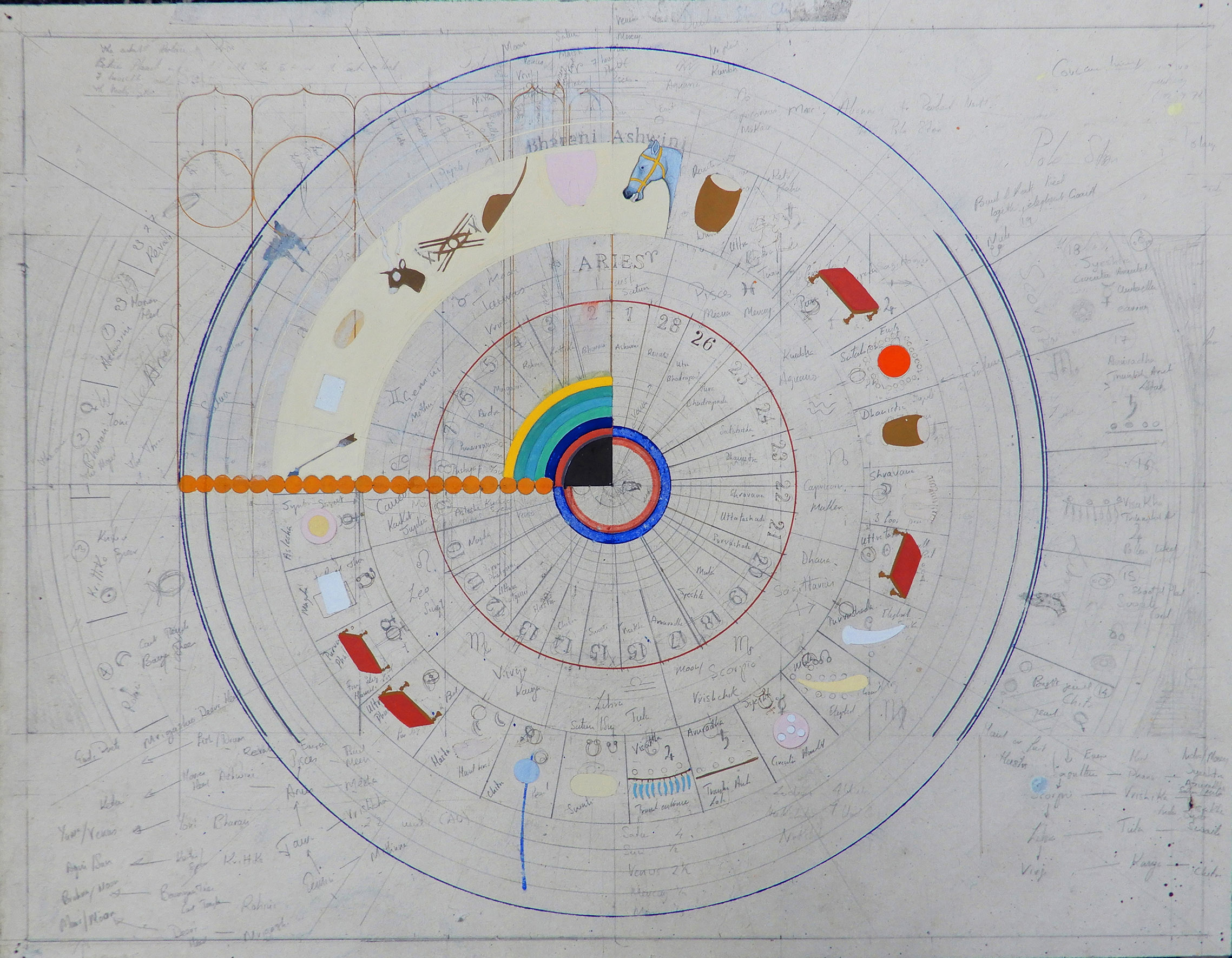
Untitled by Desmond Lazaro © Sarmaya Arts Foundation
Since prehistoric times, humans have been curious about the large unending expanse of the sky above them. The thirst to know the unknown has led us to follow the stars across oceans. To build significant monuments in honour of these enigmatic elements. To seek in them our fortunes and philosophies. And to map what is beyond the horizon. Artist Desmond Lazaro channels this primal instinct to create his own cosmos.
Cosmos comes from the Greek kosmos meaning ‘order’; it later came to signify the order of the world or the universe. Desmond’s quest to map the universe began while grieving the passing of his mother. “I recall the loss being immediate as if she had slipped into the stars, beyond anything I could imagine, a place of awe, beauty, and wonder. Strange, as I knew it, but could not comprehend it: she was there, and I was not, and yet the heavens seemed to hold us both. Grief can take many forms, mine sought comfort in stargazing in my paintings.” His recent exhibition, Cosmos, at Chemould Prescott Road in Mumbai is a result of this exploration. These works are the manifestation of his meticulous research in the fields of cosmology, astronomy, and astrophysics, interpreted through the lens of the artistic traditions he has imbibed and his relationships with materials.
Family constellations
Born in Leeds, England in 1968, Lazaro had come to India in 1990 to study art at MSU Baroda (1990-94). And it is here that he discovered an abiding interest in Rajasthani miniature art traditions. This set him on the path to a 12-year apprenticeship under miniaturist Banu Ved Pal Sharma, during which he mastered the materiality and articulation of the miniature and Pichwai traditions. Though rooted in ancient practice, Desmond uses the miniature form to talk about contemporary themes and personal journeys by diving deep into his family archive.
In his 2016 show The Incoming Passengers at Chemould Prescott Road, he explored the ideas of migration and belonging while bringing to light the personal accounts of his grandparents and parents. Desmond’s great-grandfather hailed from Madras, while his parents belonged to Burma and later moved to Leeds in 1957. Engaging with what Nancy Adjania has described as ‘radical homelessness’, the artist worked with archival family documents to trace the generational movement of his family and its consecutive ripple effects. He reveals this layered history through Indian miniatures studded with European techniques of gilded icons. While mapping his own past, Desmond studied the journeys of early explorers re-imagining Buckminster Fuller’s Dymaxion Maps. His interest in the cosmos sparked during travels in Dunhuang (Western China). It was here at the Mogao Caves, where the Dunhuang Star Atlas – the oldest star map was discovered in 1906, that Desmond’s inquiry into the heavens began.
Home among the stars

The Ptolemaic geocentric model of the Universe according to the Portuguese cosmographer and cartographer Bartolomeu Velho (Bibliothèque Nationale de France, Paris)—click for source
Like his family history, Desmond’s work moves beyond stated geographical or cultural boundaries. It reflects rigorous research as well as an intimate spiritual pursuit. Through Cosmos, he extends this idea of home and belonging from self to the wider world. He takes us on a perpetual cosmic journey that begins in Ancient Rome. Through this passage, Desmond reveals how the idea of the cosmos has evolved through the millennia, weaving some extraordinary narratives along the way. A close examination of his paintings reveals astute investigations in the field of astronomy and astrophysics. It’s an interdisciplinary approach informed by the artist’s study of medieval manuscripts, architectural expositions and alchemical processes.
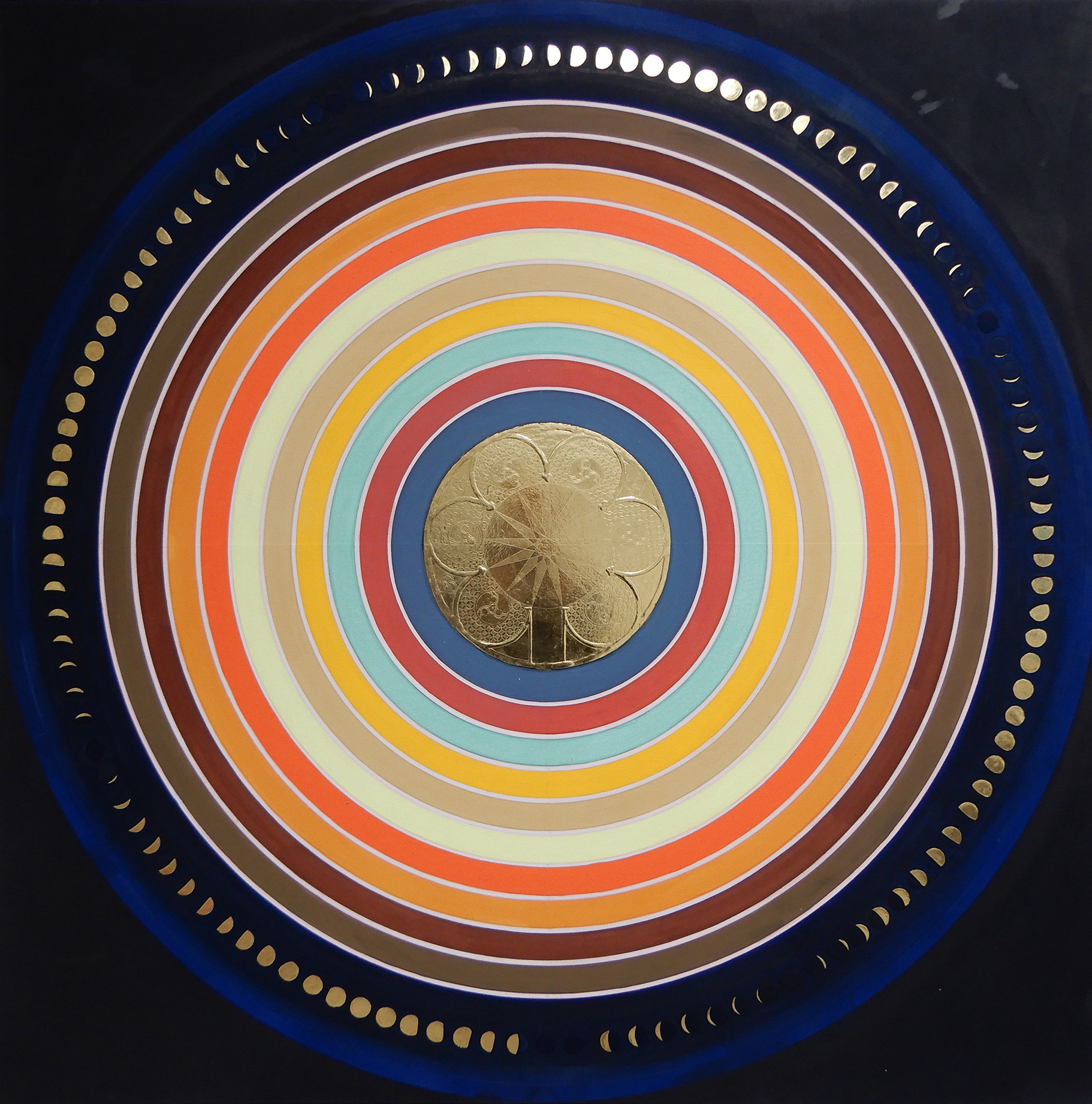
‘The Moons of Chartres II’, pigment paint on canvas with raised gesso gild, Desmond Lazaro © Sarmaya Arts Foundation
The Moons of Chartres II, is inspired by Desmond’s visit to the Labyrinth at Chartres Cathedral in France under the mentorship of Professor Keith Critchlow, who was known for his work on sacred geometry. The labyrinth was inspired by Marcus Tulius Cicero’s The Dream of Scipio (146 BCE), the story of a Roman general Scipio Aemilianus who dreams of seeing the earth from a height. The tale was influenced by Ptolemy’s geocentric (earth-centered) theory of the universe. Desmond uses raised gilding and pigments painted on a cotton cloth on a birch board to demonstrate the labyrinth as an astral journey.
What you see is a geometric drawing created by a thirteen-fold star reflected at the centre, unfolded by eleven concentric circles as pathways to reach the centre. On the periphery lies 112 phases of the moon which are divided into four quarters marking twenty-eight-day cycles. Here, Desmond has merged his fascination for medieval cosmological theories and geometry with ancient narratives that produced mystical structures. For Ptolemy, the earth was at the centre of the universe, and Scipio saw himself not as the inhabitant of Rome but of the world. As for our artist, his ‘radical homelessness’ spurs him to seek a permanent address somewhere in the celestial realms.
Secrets of the cosmos
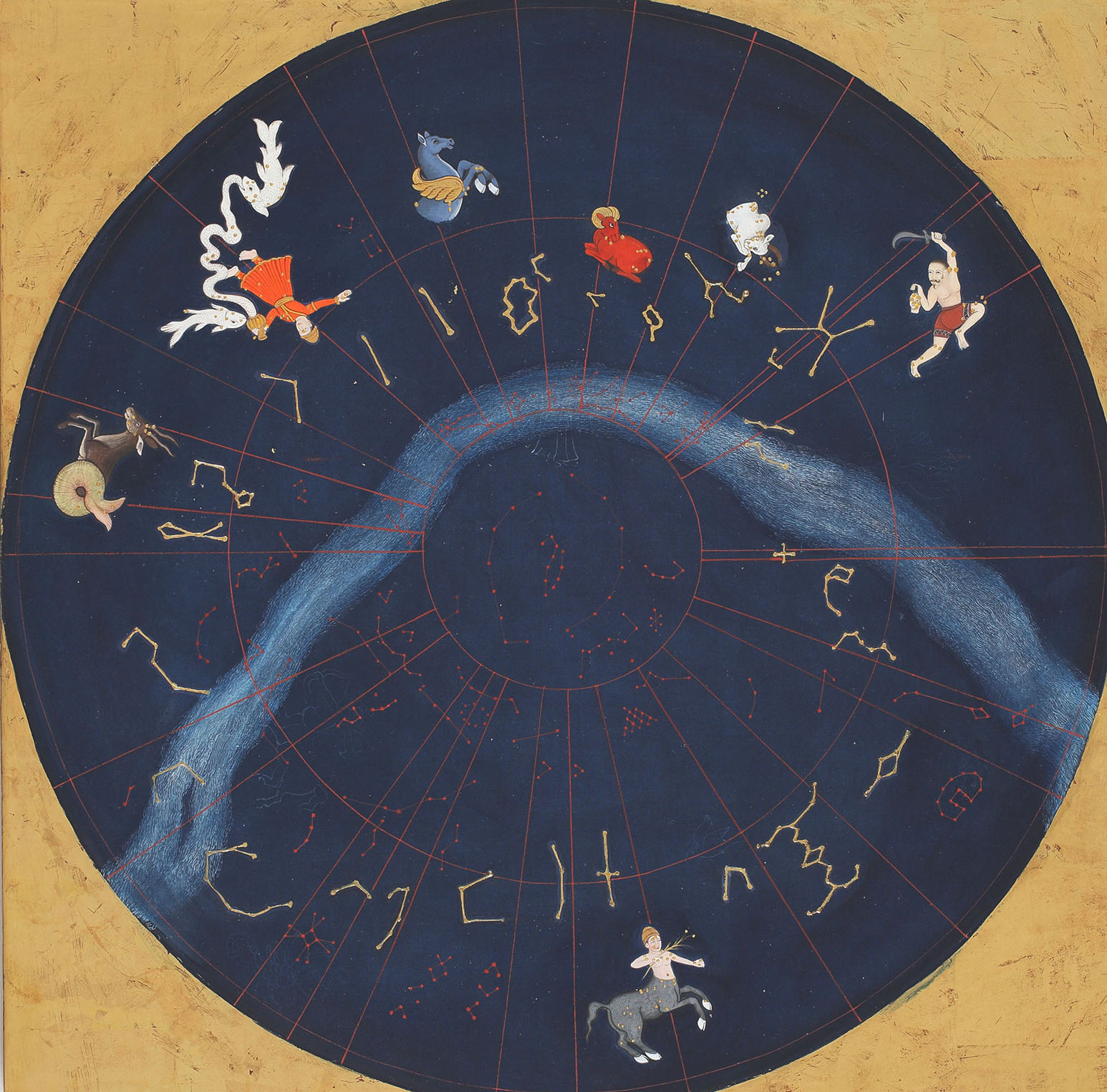
Mapping the heavens, indigo dyed cotton cloth, natural pigments and raised gold on wooden backing, Desmond Lazaro © Sarmaya Arts Foundation
Desmond extends his planetary probe by investigating the architecture of the Vastu Purusha Mandala. The earliest reference to this mandala is in Varahamihira’s 6th Century work Brhat Samhita. This period in India is significant because it represents the earliest phase of temple-building activity here. And it was the Vastu Purusha Mandala that set into motion what architectural historian Andreas Volwahsen terms “an act of bringing disordered existence into conformity with the basic laws that govern it”. A temple is a physical manifestation of cosmological symbolism. It represents a human body or Purusha. The grid of the mandala is symbolic of all cyclical time, day, month, year, and the time marked by eclipses. Desmond projects the Purusha into this grid, bringing time into existence “through which the formless becomes form”.
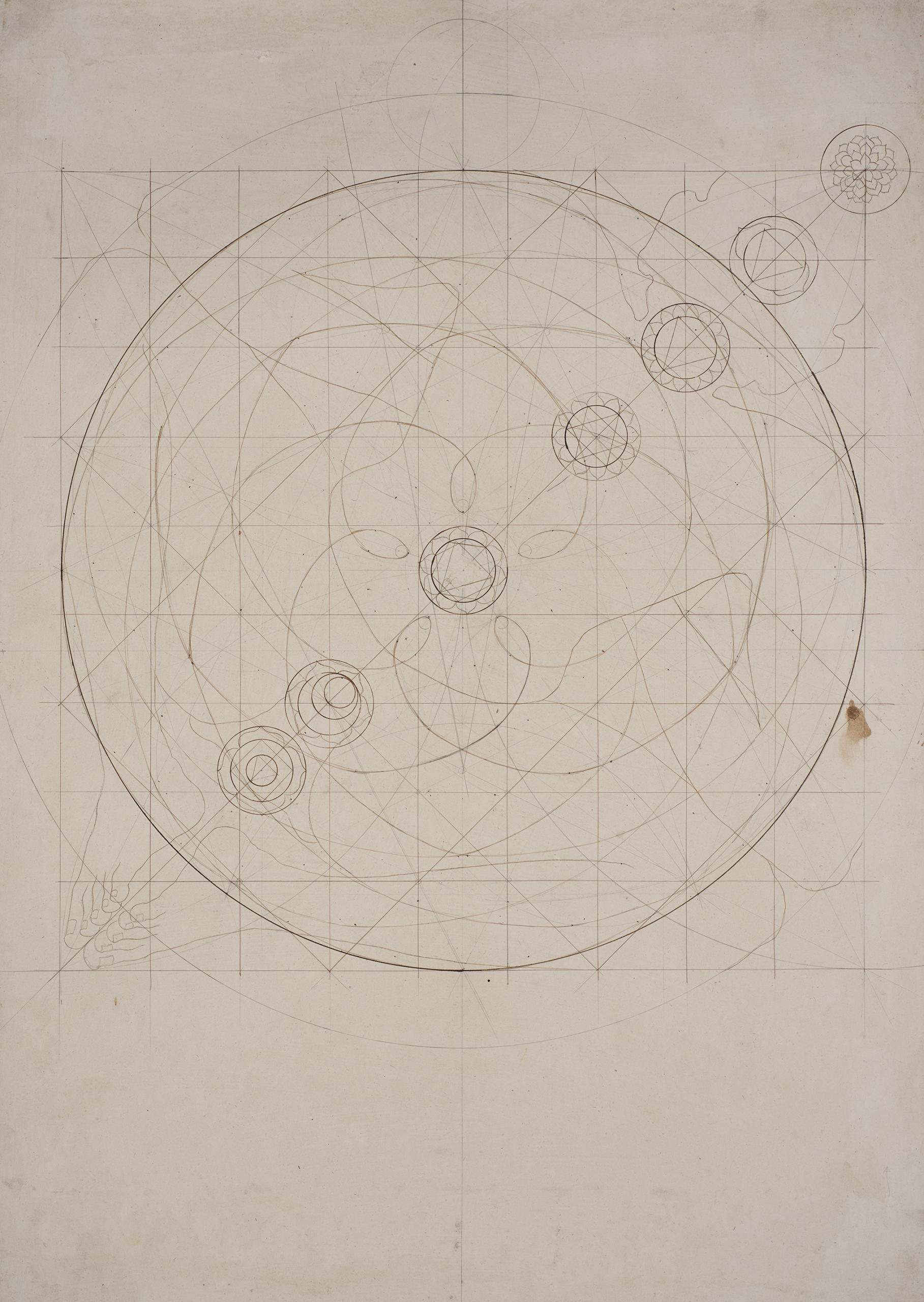
Vastu Purusha Mandala and the Star Cut Diagram, ink on paper, Desmond Lazaro
Desmond Lazaro’s plunge into historical archives to chart the trajectory of fascinating cosmological spectacles can be observed in his representations of a phenomenon known as the Venus transit. This is a rare event that happens once in over a century, when the planet passes between the Earth and can be seen silhouetted against the fiery disk of the sun. The first Venus transit was documented in a drawing in 1639 by British astronomer, Jeremiah Horrocks at Much Hoole, England. Over the years as the technologies became refined, so did the ways to capture this unique occurrence.

‘Venus Transit, The Endeavour’, Desmond Lazaro © Sarmaya Arts Foundation
In Venus Transit, The Endeavour Desmond projects the 1769 journey of Captain James Cook in the Pacific, where he observed the Transit in Tahiti. The gilded thirteen-fold star is seen against the darkness of space, which is encapsulated by a thin circular band projecting a spectrum of colours. Beneath this heavenly spectacle is The Endeavour, Cook’s ship, sailing through the emptiness.
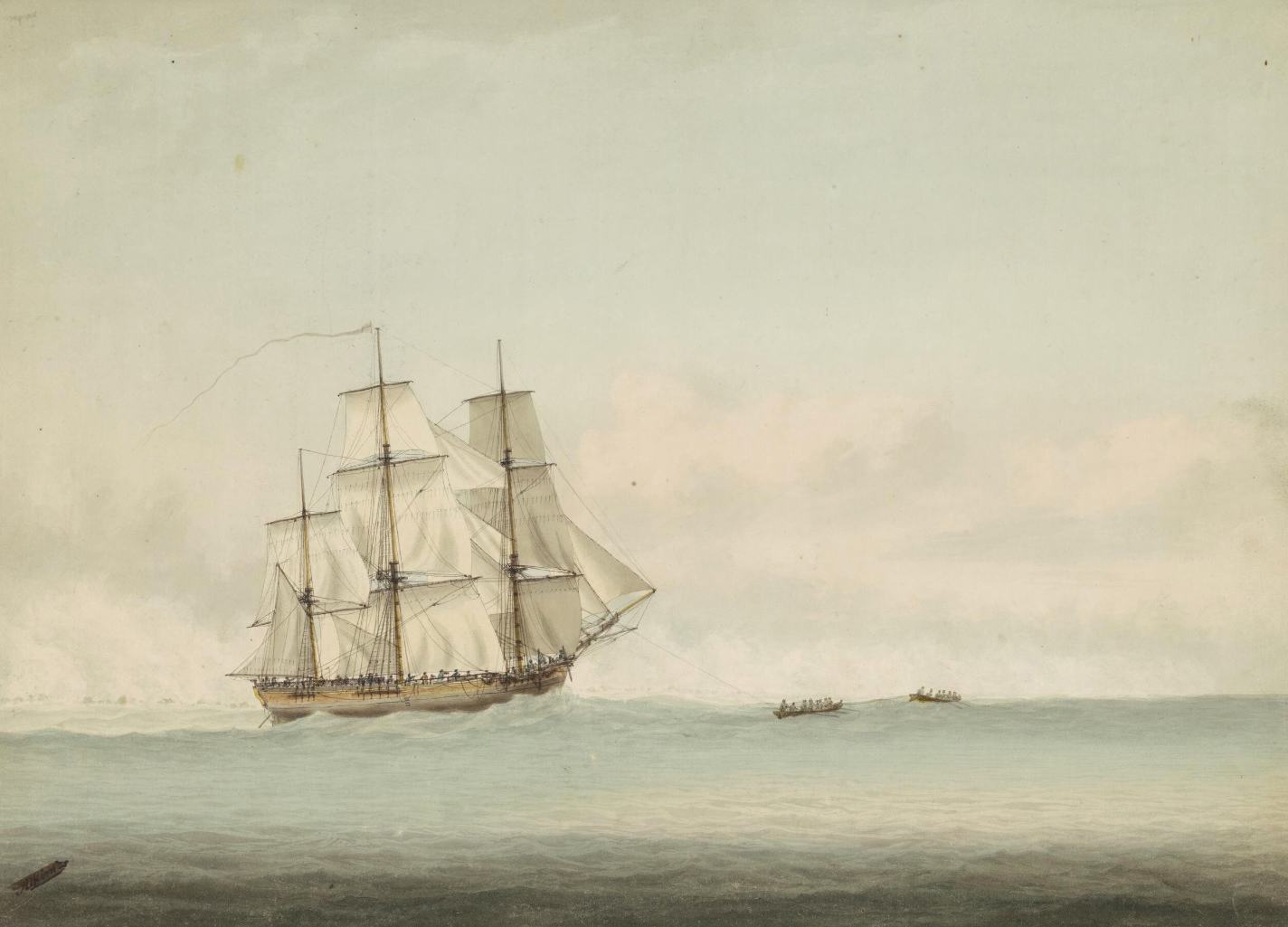
Painting by Samuel Atkins (1787-1808) of ‘Endeavour off the coast of New Holland during Cook’s voyage of discovery 1768-1771. Inscription on reverse of painting indicates it relates to the grounding of the Endeavour on the Great Barrier Reef in June 1770.
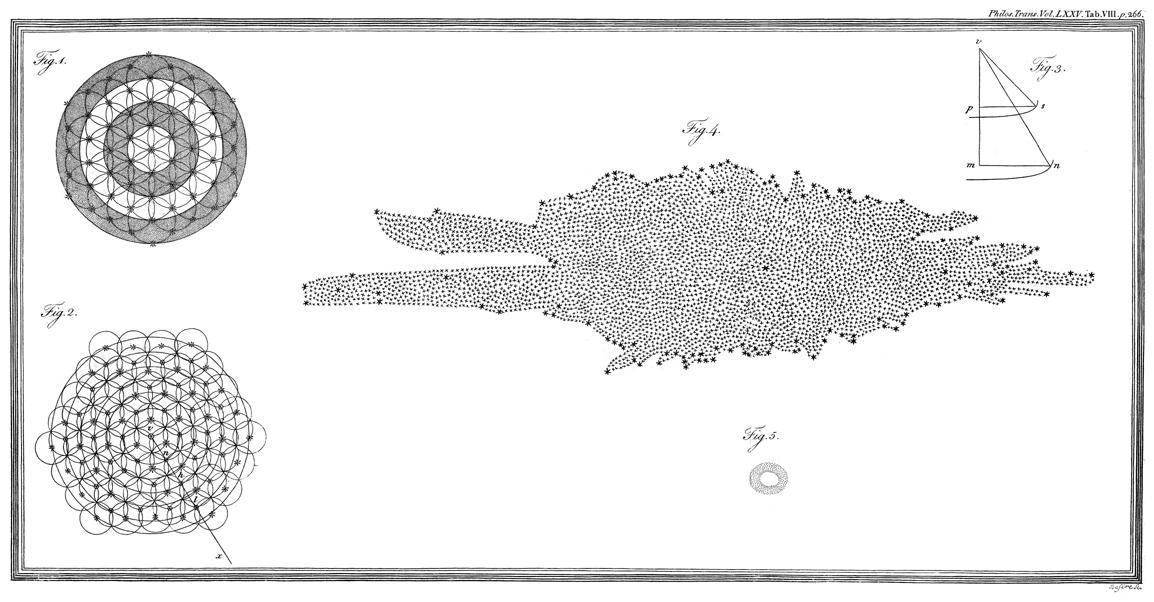
“Section of our sidereal system.” Herschel, William, 1785/Wikipedia Creative Commons
With his investigation into the astronomical realm, Desmond takes us back to when the first modern image of The Milky Way was created by Herschel. William Herschel was an 18th Century British astronomer and a telescope-maker who would go on to identify Uranus with his sister Caroline. But his most valuable contribution to astronomy was the drawing ‘Model of the Milky Way’ in 1785. Herschel would plot the night sky, section by section, mapping what he saw from 600 locations. Every identified star, based on its size, was marked as a simple cross. The data was evaluated and stitched together creating the first standard non-circular image of our galaxy. Desmond’s mark-making resembles Herschel’s and the artist mirrors the astronomer’s galaxy with a cluster of crosses marked by gold leaf-raised gild on paper. He also creates the map of stars in brass as an installation for the viewer to lay back and observe the same sky as Herschel once did.
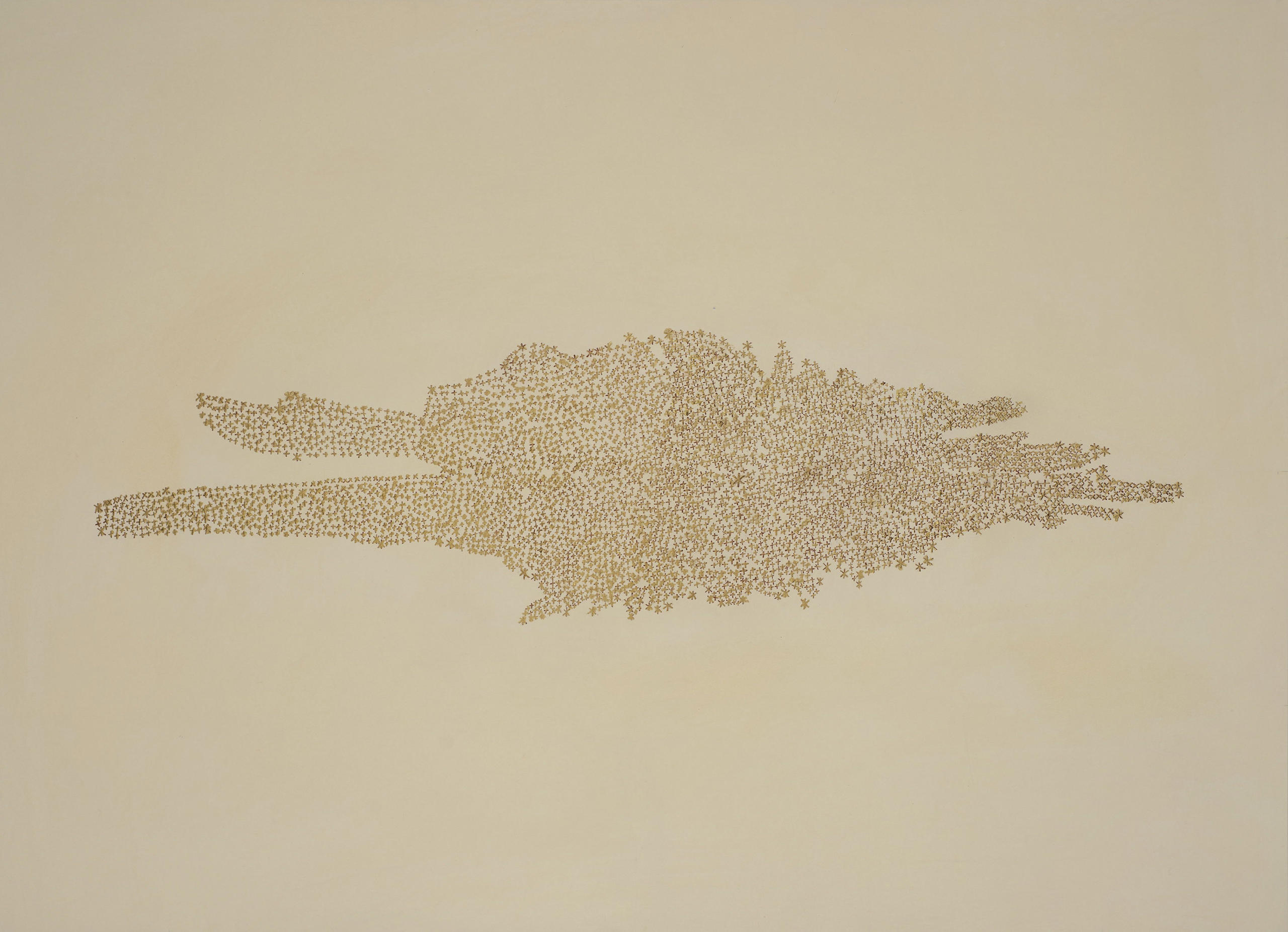
‘Herschel’s Galaxy I’, Desmond Lazaro © Sarmaya Arts Foundation
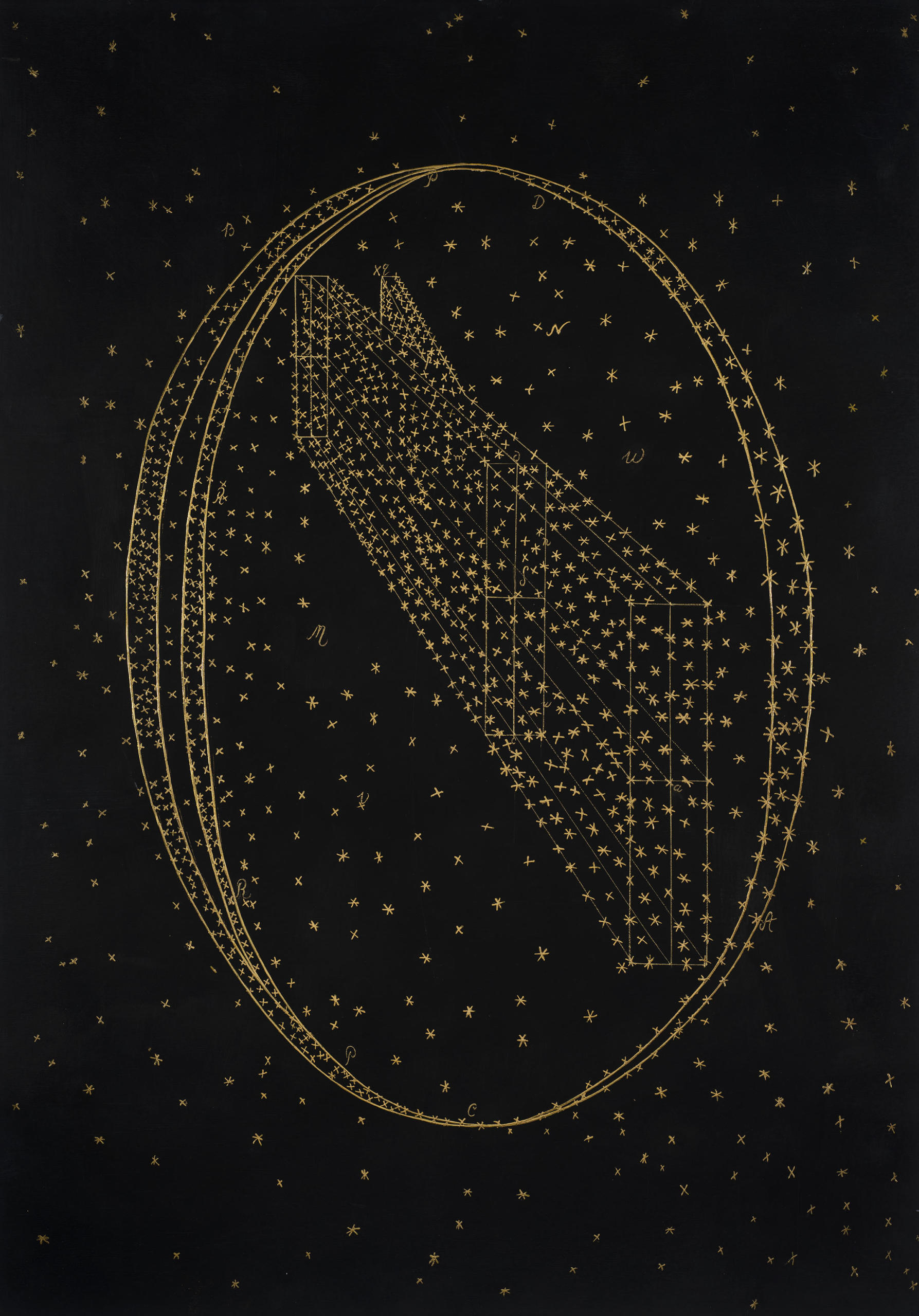
‘Herschel I’, raised gold gild on gesso paper, Desmond Lazaro © Sarmaya Arts Foundation
Celestial colours

‘Study III: Sea of Untold Stories’, handmade pigment paint on cotton cloth, Desmond Lazaro © Sarmaya Arts Foundation
Just like Ptolemy placed the Earth at the centre of the universe, Desmond Lazaro centres his practice around alchemical processes that birth earthy pigments. Colour is a fundamental part of his work and he has made his own pigments for years, the result of his apprenticeship at the Jaipur miniature studio. In Cosmos, Desmond explores colours associated with planets and their unique symbolism. “The scarlet red of pure vermillion, made from cinnabar (mercury sulphate) and its association to the planet Mercury, seemed quite natural,” observes the artist in the literature accompanying the series.
He braids alchemical traditions with Newton’s colour prism and 18th-Century astronomer Father Angelo Secchi’s illustrations of a star’s light spectrum. For Desmond Lazaro, colour is an earthly manifestation of the planets. Immersing himself in the process of making colour is how he engages with the planets and the stars every day, slowly unravelling the mysteries of his own cosmos.
References
- Interview with Desmond Lazaro.
- Cosmos by Desmond Lazaro (a publication of the exhibition)
- Desmond Lazaro
- Desmond Lazaro | Chemould Prescott Road
- Meister, M. W. (1979). Maṇḍala and Practice in Nāgara Architecture in North India. Journal of the American Oriental Society, 99(2), 204–219.
- The Transit of Venus – Jeremiah Horrocks Institute



